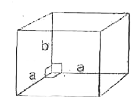State the type of crystal defects shown by AgBr.
To determine the types of crystal defects shown by AgBr (Silver Bromide), we can analyze the characteristics of the crystal structure and the nature of the defects.
1. Understanding Crystal Defects:
- Crystal defects are irregularities in the crystal lattice that can affect the properties of the material. The two main types of point defects are Schottky defects and Frenkel defects.
2. Identifying Schottky Defect:
- A Schottky defect occurs when equal numbers of cations and anions are missing from the lattice. This results in a decrease in the density of the crystal because the mass of the crystal is reduced while the volume remains the same.
- In AgBr, both Ag⁺ (silver ion) and Br⁻ (bromide ion) can be absent from their lattice sites, leading to the formation of Schottky defects.
3. Identifying Frenkel Defect:
- A Frenkel defect occurs when a cation or anion leaves its lattice site and occupies an interstitial site. This means that while one ion is missing from its original position, it is not lost from the crystal entirely, as it is now located in a different position within the lattice.
- In AgBr, the Ag⁺ ion, which is relatively small, can move from its lattice site to an interstitial site, leading to the formation of a Frenkel defect.
4. Conclusion:
- AgBr exhibits both types of defects: Schottky defects due to the absence of equal numbers of Ag⁺ and Br⁻ ions, and Frenkel defects due to the mobility of the small Ag⁺ ions that can occupy interstitial sites.
Final Answer:
AgBr shows both Schottky and Frenkel defects.
---
- Crystal defects are irregularities in the crystal lattice that can affect the properties of the material. The two main types of point defects are Schottky defects and Frenkel defects.
- A Schottky defect occurs when equal numbers of cations and anions are missing from the lattice. This results in a decrease in the density of the crystal because the mass of the crystal is reduced while the volume remains the same.
- In AgBr, both Ag⁺ (silver ion) and Br⁻ (bromide ion) can be absent from their lattice sites, leading to the formation of Schottky defects.
- A Frenkel defect occurs when a cation or anion leaves its lattice site and occupies an interstitial site. This means that while one ion is missing from its original position, it is not lost from the crystal entirely, as it is now located in a different position within the lattice.
- In AgBr, the Ag⁺ ion, which is relatively small, can move from its lattice site to an interstitial site, leading to the formation of a Frenkel defect.
- AgBr exhibits both types of defects: Schottky defects due to the absence of equal numbers of Ag⁺ and Br⁻ ions, and Frenkel defects due to the mobility of the small Ag⁺ ions that can occupy interstitial sites.
AgBr shows both Schottky and Frenkel defects.
Topper's Solved these Questions
- SOLID STATEBOOK - MODERN PUBLICATIONCHAPTER - SOLID STATEEXERCISE - REVISION EXERCISES (VERY SHORT ANSWER QUESTIONS) (CBSE Qs)
5 Videos
- SOLID STATEBOOK - MODERN PUBLICATIONCHAPTER - SOLID STATEEXERCISE - REVISION EXERCISES (SHORT ANSWER QUESTIONS)
42 Videos
- SOLID STATEBOOK - MODERN PUBLICATIONCHAPTER - SOLID STATEEXERCISE - REVISION EXERCISES (OBJECTIVE QUESTIONS) (ASSERTION REASON QUESTIONS)
10 Videos
- POLYMERSBOOK - MODERN PUBLICATIONCHAPTER - POLYMERSEXERCISE - Competition file (OBJECTIVE TYPE QUESTIONS) (C. MULTIPLE CHOICE QUESTIONS)(Integer Type Questions)
6 Videos
- SOLUTIONSBOOK - MODERN PUBLICATIONCHAPTER - SOLUTIONSEXERCISE - UNIT PRACTICE TEST
14 Videos
Similar Questions
Knowledge Check
The type of crystal system shown is
 ACubicBOrthorhombicCMonoclinicDTetragonal
ACubicBOrthorhombicCMonoclinicDTetragonalStatement-1 :Schottky type of defect is shown by crystals with high co-ordination numbers .
Statement-2 :In Schottky defect , equal number of cations and anions are missing from their lattice sitesAStatement-1 is true, statement-2 is true, statement-2 is a correct explanation for statement-1BStatement-1 is true, statement-2 is true, statement-2 is not correct explanation for statement-1CStatement-1 is true, statement-2 is falseDStatement-1 is false, statement-2 is true
Some crystal defects are shown in the figures below :

Indicate the types of defect shown by (a) and (b).
View SolutionWhat type of stoichiometric defect is shown by AgCl ?
View SolutionWhat type of stoichiometric defect is shown by AgCl?
View SolutionWhat type of stoichiometric defect is shown by AgCl ?
View SolutionWhat type of stoichiometric defect is shown by:
(a) ZnS (b) AgBr
View SolutionWhat type of stoichiometric defect is shown by :
(i) Zns(ii) AgBr
View Solution
